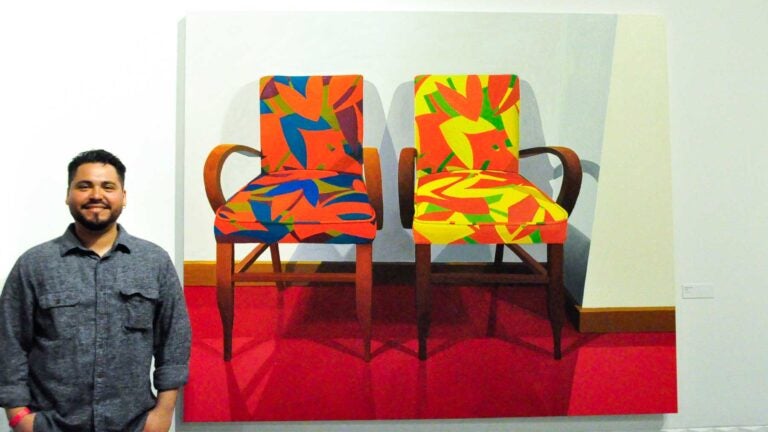
Roberto Ortiz drew from observations at his day job to create a painting on display at the USC Fisher Museum of Art. (Photo/Nick Arciero)
Community artists get helping hand with USC Fisher residency, exhibit
Participants in Art Division, a Westlake nonprofit, took lessons with some of USC’s top artists, then displayed their own work
During his downtime as an usher at the Walt Disney Concert Hall, Roberto Ortiz would sketch the chairs.
The chairs had wooden arms and legs and were covered in vibrant fabric — a geometric pattern in bright colors.
“Something about them caught my attention,” said Ortiz, 25.
Now the chairs are on canvases, three of them, stretching the length of nearly one entire wall at the USC Fisher Museum of Art, part of Artists in Residence: The Exhibition.
Ortiz, of Koreatown, is part of Art Division, a nonprofit in the Westlake neighborhood of Los Angeles that provides art classes and training to young adults. Sixteen participants in the program are featured in the USC Fisher show, their work spanning two rooms. It runs through April 8.
Who wouldn’t be excited to get the privilege to show at a museum?
Roberto Ortiz
“Who wouldn’t be excited to get the privilege to show at a museum?” Ortiz said.
Many of those in the show are from low-income immigrant communities around the Westlake area.
Prior to the show, the participants got three weeks of free workshops — a first at USC. Throughout January and February, the young artists came to the University Park Campus to do figure drawing alongside Professor Margaret Lazzari of the USC Roski School of Art and Design or get coached on public speaking from Assistant Professor Randy Mell of the USC School of Dramatic Arts.
Members of the community were invited to the workshops as well.
Native talent
“I would say they had an amazing amount of native talent,” Lazzari said of the Art Division participants.
Art Division Founder Dan McCleary said the show expected the young artists to work at a level they’d never worked at before, and “they rose to the challenge.”
“A lot of them haven’t had the GPA to get into good colleges, but their visual thinking is incredibly sophisticated,” he said. “I think it’s going to change many aspects of these students’ lives.”
Alfredo Alvarado, 20, has four pieces on display in the show. Rather than being done on canvas, Alvarado’s art is on reclaimed cardboard he found on the street, got from his family or found while rifling through the recycling bins. He even borrowed some from fellow students.
“They ordered their canvases and those [cardboard] boxes they came in — I took them and painted on them,” he said.
He said the material is “common and ignored” and he wanted to change that.
[new_royalslider id=”171″]
Alvarado, who is gay, likes to bring up LGBTQ issues in his work. His piece “Transition” reinterprets Sandro Botticelli’s “The Birth of Venus” with a queer character.
“Morning Heartbreak” and “Nightly Passion” show the narrative of a relationship, two lovers meeting under the cover of moonlight, awaking one day to the end of their relationship. A pyramid sculpture asks museumgoers to reflect on that work: “Even with the normalization of our love, queer love … we can’t forget the historical discrimination and the discrimination that still happens in our time,” Alvarado said.
Growing up next to USC, Alvarado said he used to walk the campus occasionally but never felt truly connected to the university — until now.
We wanted to give them the chance to get the university setting they’d never imagine they’d be in.
Selma Holo
“We wanted to give them the chance to get the university setting they’d never imagine they’d be in,” museum Director Selma Holo said.
Holo got the idea for the exhibit from her relationship with McCleary, who has exhibited work at the Fisher.
“I knew this was one of the great things going on in L.A. in terms of helping transform a sector of society,” she said of Art Division.
But instead of just showing the work, “I thought could we do something more interesting,” coming up with the idea of the residency program. USC art history students also interviewed all the exhibitors for a catalog on the show.
Ambitious effort
The result is one of the most ambitious projects USC Fisher has done — and ambitious for a university museum, Holo said.
Provost Michael Quick said he was proud of the effort.
“This is an exciting program for USC,” Quick said. “Art Division’s emerging artists are getting access to excellent artists and receiving new training that will help them be even more successful. This is a wonderful collaboration between a university-owned museum and a community nonprofit. It shows exactly how this university can offer access and opportunity and become true partners as artists for social change.”
Ortiz, who got into art tagging graffiti, has to pinch himself a little.
“It’s kind of surreal, you know,” he said.
Raised mostly by his single mother, a housekeeper, he said the support from Art Division and the community has made him want to go back to school to pursue a bachelor’s in art, perhaps even a master’s degree. Art Division recently helped him get a job working for an artist in Culver City.
“It’s something that I’m really proud of,” he said of the exhibit at USC. “I want to keep making art.”
